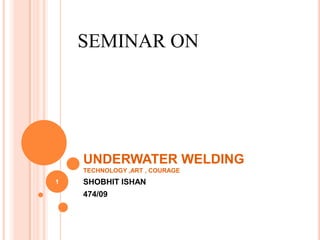Underwater welding
- 1. SEMINAR ON UNDERWATER WELDING TECHNOLOGY ,ART , COURAGE 1 SHOBHIT ISHAN 474/09
- 2. âĒ First under water welding by British Admiralty â Dockyard âĒ In 1946, special waterproof electrodes were developed in Holland by âVan der Willingenâ 2
- 4. We cant lift ship and then repair it. Hence comes the use of underwater welding 4
- 5. âĒWet welding 5 âĒDry welding
- 6. Hyperbaric welding is the process in which a chamber is sealed around the structure to be welded and is filled with a gas ( He and Oxygen) at the prevailing pressure. 6
- 7. Dry welding can be of two types âĒLarge habitat âĒMini habitat 7 Mini habitat for underwater welding.
- 8. Source: north stream Large habitat for 8 underwater welding
- 9. 9 Large habitat underwater welding
- 10. âĒWelder /diver safety âĒGood weld quality âĒSurface monitoring 10
- 11. âĒ Higher cost of process, training, etc âĒ Large quantity of costly and complex equipments âĒ More deep, more energy requirement. âĒ Cant weld if weld spot is at unreachable place 11
- 12. âĒ Simply means that job is performed directly in the water âĒ It involves using special rod and is similar to the process in ordinary air welding 12
- 13. 13
- 14. âđ#âš
- 15. âĒ WATER-------------ï HYDROGEN + OXYGEN âĒ Dissolve in weld pool âĒ Solubility decrases and then comes out - ï porosity âĒ Oxygen as solid , liquid inclusions or gases âĒ Hydrogen combines with oxygen forming vapour 15
- 16. Chemical composition 16
- 17. Porosity-troubleshooted by including Calcium carbonate 17
- 19. âĒ Effect of alloying elements on weld metal microstructure and properties âĒ Managanese âĒ Boron and titanium âĒ Rare earth metals 19
- 20. âĒ Cheapest âĒ Fastest âĒ Tensile strength is high âĒ Ease of access the weld spot âĒ No waste of time in constructing habitat 20
- 21. âĒ Rapid quenching decreases impact strength, Ductility. âĒ Hydrogen embrittlement. âĒ Poor visibility in water. âĒ Higher energy density of hydrogen, higher efficiency. 21
- 22. âĒ Power supply requrements-400 amp or larger. DC generators, motor generators and rectifiers are acceptable power supplies âĒ Power converters. âĒ Welding Generator, Pre-Setup âĒ Polarity. âĒ Diesel Driven Welding Generator Amperage and Voltage settings. âĒ Gas Manifolds. 22
- 23. âĒ Underwater Oxygen-Arc Welding Torches.- Collet or grip Oxygen valve Flash arrester âĒ Waterproofing Surface Electrodes. Epoxy 152 Lee lac 30-l2093 Polyurethane 23
- 24. Figure showing schematic diagram for underwater welding or cutting 24
- 25. âĒ Hydrogen and oxygen are dissociated from the water and will travel separately as bubbles âĒ Oxygen cutting is about 60 percent efficient âĒ Above river beds, especially in mud, because trapped methane gas in the proper concentrations can explode. 25
- 26. âĒ There is a risk to the welder/diver of electric shock. âĒ There is a risk that defects may remain undetected âĒ The other main area of risk is to the life or health of the welder/diver from nitrogen introduced into the blood steam during exposure to air at increased pressure 26
- 27. âĒ Start cutting at the highest point and work downward âĒ By withdrawing the electrode every few seconds to allow water to enter the cut âĒ Gases may be vented to the surface with a vent tube (flexible hose) secured in place from the high point where gases would collect to a position above the waterline. 27
- 28. âĒ Precautions include achieving adequate electrical insulation of the welding equipment âĒ Areas and voids must be vented or made inert 28
- 29. âĒ Development of alternative welding methods like friction welding, explosive welding, and stud welding. âĒ Present trend is towards automation. THOR â 1 (TIG Hyperbaric Orbital Robot) is developed where diver performs pipefitting, installs the track and orbital head on the pipe and the rest process is automated. 29
- 30. 30






























